#prunes
Explore tagged Tumblr posts
Text
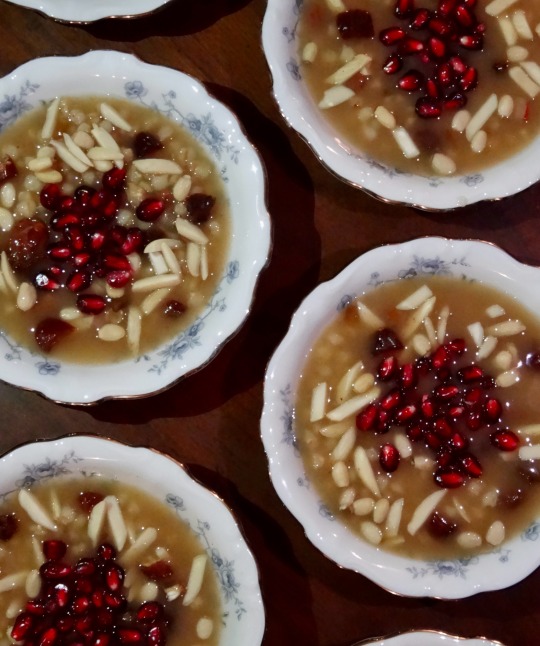
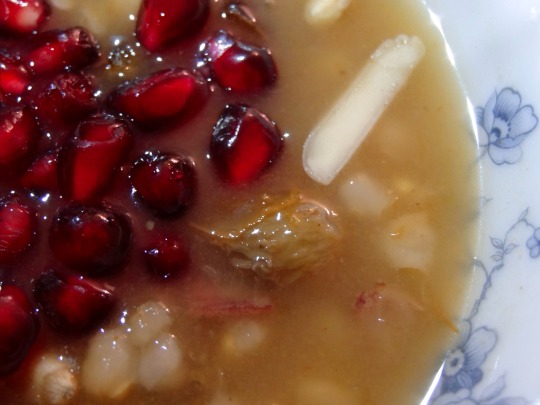
[ID: First image shows four small porcelain bowls of a pudding topped with slivered almonds and pomegranates seeds, seen from above. Second image is an extreme close-up showing the blue floral pattern on the china, slivered almonds, golden raisins, and pomegranate seeds on top of part of the pudding. End ID]
անուշապուր / Anush apur (Armenian wheat dessert)
Anush apur is a sweet boiled wheat pudding, enriched with nuts and dried fruits, that is eaten by Armenians to celebrate special occasions. One legend associates the dish with Noah's Ark: standing on Mt. Ararat (Արարատ լեռը) and seeing the rainbow of God's covenant with humanity, Noah wished to celebrate, and called for a stew to be prepared; because the Ark's stores were diminishing, the stew had to be made with small amounts of many different ingredients.
The consumption of boiled grains is of ancient origin throughout the Levant and elsewhere in West Asia, and so variations of this dish are widespread. The Armenian term is from "անուշ" ("anush") "sweet" + "ապուր" ("apur") "soup," but closely related dishes (or, arguably, versions of the same dish) have many different, overlapping names.
In Arabic, an enriched wheat pudding may be known as "سْنَينِيّة" ("snaynīyya"), presumably from "سِنّ" "sinn" "tooth" and related to the tradition of serving it on the occasion of an infant's teething; "قَمْح مَسْلُوق" ("qamḥ masluq"), "boiled wheat"; or "سَلِيقَة" ("salīqa") or "سَلِيقَة القَمْح" ("salīqa al-qamḥ"), "stew" or "wheat stew," from "سَلَقَ" "salaqa" "to boil." Though these dishes are often related to celebrations and happy occasions, in some places they retain an ancient association with death and funerary rites: qamh masluq is often served at funerals in the Christian town of بَيْت جَالَا ("bayt jālā," Beit Jala, near Bethlehem).
A Lebanese iteration, often made with milk rather than water, is known as "قَمْحِيَّة" ("qamḥīyya," from "qamḥ" "wheat" + "ـِيَّة" "iyya," noun suffix).
A similar dish is known as "بُرْبَارَة" ("burbāra") by Palestinian and Jordanian Christians when eaten to celebrate the feast of Saint Barbara, which falls on the 4th of December (compare Greek "βαρβάρα" "varvára"). It may be garnished with sugar-coated chickpeas and small, brightly colored fennel candies in addition to the expected dried fruits and nuts.
In Turkish it is "aşure," from the Arabic "عَاشُوْرَاء" ("'āshūrā"), itself from "عَاشِر" ("'āshir") "tenth"—because it is often served on the tenth day of the month of ٱلْمُحَرَّم ("muḥarram"), to commemorate Gabriel's teaching Adam and Eve how to farm wheat; Noah's disembarkment from the Ark; Moses' parting of the Red Sea; and the killing of the prophet الْحُسَيْن بْنِ عَلِي (Husayn ibn 'Ali), all of which took place on this day in the Islamic calendar. Here it also includes various types of beans and chickpeas. There is also "diş buğdayı," "tooth wheat" (compare "snayniyya").
These dishes, as well as slight variations in add-ins, have varying consistencies. At one extreme, koliva (Greek: "κόλλυβα"; Serbian: "Кољиво"; Bulgarian: "Кутя"; Romanian: "colivă"; Georgian: "კოლიო") is made from wheat that has been boiled and then strained to remove the boiling water; at the other, Armenian anush apur is usually made thin, and cools to a jelly-like consistency.
Anush apur is eaten to celebrate occasions including New Year's Eve, Easter, and Christmas. In Palestine, Christmas is celebrated by members of the Armenian Apostolic church from the evening of December 24th to the day of December 25th by the old Julian calendar (January 6th–7th, according to the new Gregorian calendar); Armenian Catholics celebrate on December 24th and 25th by the Gregorian calendar. Families will make large batches of anush apur and exchange bowls with their neighbors and friends.
The history of Armenians in Palestine is deeply interwoven with the history of Palestinian Christianity. Armenian Christian pilgrimages to holy sites in Palestine date back to the 4th century A.D., and permanent Armenian monastic communities have existed in Jerusalem since the 6th century. This enduring presence, bolstered by subsequent waves of immigration which have increased and changed the character of the Armenian population in Palestine in the intervening centuries, has produced a rich history of mutual influence between Armenian and Palestinian food cultures.
In the centuries following the establishment of the monasteries, communities of Armenian laypeople arose and grew, centered around Jerusalem's Վանք Հայոց Սրբոց Յակոբեանց ("vank hayots surbots yakobeants"; Monastery of St. James) (Arabic: دَيْر مَار يَعْقُوب "dayr mār ya'qūb"). Some of these laypeople were descended from the earlier pilgrims. By the end of the 11th century, what is now called the Armenian Quarter—an area covering about a sixth of the Old City of Jerusalem, to the southwest—had largely attained its present boundaries.
Throughout the 16th and 17th centuries, the Patriarchate in Jerusalem came to have direct administrative authority over Armenian Christians across Palestine, Lebanon, Egypt, and Cyprus, and was an important figure in Christian leadership and management of holy sites in Jerusalem (alongside the Greek Orthodox and Roman Catholic churches). By the middle of the 19th century, a small population of Armenian Catholics had joined the larger Armenian Apostolic community as permanent residents in Jerusalem, living throughout the Muslim Quarter (but mostly in a concentrated enclave in the southwest); in the beginning of the 20th century, there were between 2,000 and 3,000 Armenians of both churches in Palestine, a plurality of whom (1,200) lived in Jerusalem.
The Turkish genocide of Armenians beginning in 1915 caused significant increases in the populations of Armenian enclaves in Palestine. The Armenian population in Jerusalem grew from 1,500 to 5,000 between the years of 1918 and 1922; over the next 3 years, the total number of Armenians in Palestine (according to Patriarchate data) would grow to 15,000. More than 800 children were taken into Armenian orphanages in Jerusalem; students from the destroyed Չարխափան Սուրբ Աստվածածին վանք (Charkhapan Surb Astvatsatsin Monastery) and theological seminary in Armash, Armenia were brought to the Jerusalem Seminary. The population of Armenian Catholics in the Muslim Quarter also increased during the first half of the 20th century as immigrants from Cilicia and elsewhere arrived.
The immediate importance of feeding and housing the refugees despite a new lack of donations from Armenian pilgrims, who had stopped coming during WW1—as well as the fact that the established Armenian-Palestinians were now outnumbered by recent immigrants who largely did not share their reformist views—disrupted efforts on the part of lay communities and some priests to give Armenian laypeople a say in church governance.
The British Mandate, under which Britain assumed political and military control of Palestine from 1923–1948, would further decrease the Armenian lay community's voice in Jerusalem (removing, for example, their say in elections of new church Patriarchs). The British knew that the indigenous population would be easier to control if they were politically and socially divided into their separate religious groups and subjected to the authority of their various religious hierarchies, rather than having direct political representation in government; they also took advantage of the fact that the ecclesiastical orders of several Palestinian Christian sects (including the Armenian Patriarchate of Jerusalem) comprised people from outside of Palestine, who identified with religious hierarchy and the British authorities more than they identified with the Palestinian lay communities.
British policy, as well as alienating Armenians from politics affecting their communities, isolated them from Arab Palestinians. Though the previously extant Armenian community (called "քաղաքացի" "kaghakatsi," "city-dwellers") were thoroughly integrated with the Arab Palestinians in the 1920s, speaking Arabic and Arabic-accented Armenian and eating Palestinian foods, the newer arrivals (called "زُوَّار" / "զուվվար" "zuwwar," "visitors") were unfamiliar with Palestinian cuisine and customs, and spoke only Armenian and/or Turkish. Thus British policies, which differentiated people based on status as "Arab" (Muslim and Christian) versus "Jewish," left new Armenian immigrants, who did not identify as Arab, disconnected from the issues that concerned most Palestinians. They were predominantly interested in preserving Armenian culture, and more concerned with the politics of the Armenian diaspora than with local ones.
Despite these challenges, the Armenian Patriarchate of Jerusalem came to be a vital center of religious and secular culture for the Armenian diaspora during the British Mandate years. In 1929, Patriarch Yeghishe Turian reëstablished the Սուրբ Յակոբեանց Տպարան ("surbots yakobeants taparan"; St. James printing house); the Patriarchate housed important archives relating to the history of the Armenian people; pilgrimages of Armenians from Syria, Lebanon, and Egypt increased and the economy improved, attracting Armenian immigrants in higher numbers; Armenians held secular roles in governance, policing, and business, and founded social, religious, and educational organizations and institutions; Armenians in the Old and New Cities of Jerusalem were able to send financial aid to Armenian victims of a 1933 earthquake in Beirut, and to Armenians expelled in 1939 when Turkey annexed Alexandretta.
The situation would decline rapidly after the 1947 UN partition resolution gave Zionists tacit permission to expel Palestinians from broad swathes of Palestine. Jerusalem, intended by the plan to be a "corpus separatum" under international administration, was in fact subjected to a months-long war that ended with its being divided into western (Israeli) and eastern (Palestinian) sections. The Armenian population of Palestine began to decline; already, 1947 saw 1,500 Armenians resettled in Soviet Armenia. The Armenian populations in Yafa and Haifa would fall yet more significantly.
Still, the Armenian Patriarchate of Jerusalem maintained its role as the center of Armenian life in Palestine; the compound provided food and shelter to thousands of Armenians during the Battle for Jerusalem and the Nakba (which began in 1948). Some Armenians formed a militia to defend the Armenian Quarter against Haganah shelling during the battle.
In the following years, historical British contributions to the shoring up of insular power in the Patriarchate would cause new problems. The Armenian secular community, no longer empowered to oversee the internal workings of the Patriarchate, could do nothing to prevent embezzling, corruption, and even the sale of church-owned land and buildings to settlers.
In 1967, Israeli military forces annexed East Jerusalem, causing another, albeit smaller, surge in Armenian emigration from the city. Daphne Tsimhoni estimates based on various censuses that the Armenian population of Jerusalem, which had reached 5,000-7,000 at its peak in 1945–6, had fallen back to 1,200 by 1978.
Today, as in the 20th century, Armenians in Jerusalem (who made up nearly 90% of the Armenian population of Palestine as of 1972) are known for the insularity of their community, and for their skill at various crafts. Armenian food culture has been kept alive and well-defined by successive waves of immigrants. As of 2017, the Armenian Patriarchate supplied about 120 people a day with Armenian dishes, including Ղափամա / غاباما "ghapama" (pumpkin stuffed with rice and dried fruits), թոփիկ / توبيك "topig" (chickpea-and-potato dough stuffed with an onion, nut, fruit, and herb filling, often eaten during Lent), and Իչ / ايتش "eetch" (bulgur salad with tomatoes and herbs).
Restaurants lining the streets of the Armenian and Christian quarters serve a mixture of Armenian and Palestinian food. Լահմաջո "lahmadjoun" (meat-topped flatbread), and հարիսա / هريس "harisa" (stew with wheat and lamb) are served alongside ֆալաֆել / فلافل ("falafel") and մուսախան / مسخن ("musakhkhan"). One such restaurant, Taboon Wine Bar, was the site of a settler attack on Armenian diners in January 2023.
Up until 2023, despite fluctuations in population, the Armenian community in Jerusalem had been relatively stable when compared to other Armenian communities and to other quarters of the Old City; the Armenian Quarter had not been subjected to the development projects to which other quarters had been subjected. However, a deal which the Armenian Patriarchate had secretly and unilaterally made with Israel real estate developer Danny Rotham in 2021 to lease land and buildings (including family homes) in the Quarter led Jordan and Palestine to suspend their recognition of the Patriarch in May of 2023.
On 26th October, the Patriarchate announced that it was cancelling the leasing deal. Later the same day, Israeli bulldozers tore up pavement and part of a wall in حديقة البقر ("ḥadīqa al-baqar"; Cows' Garden; Armenian: "Կովերի այգու"), the planned site of a new luxury hotel. On 5th November, Rothman and other representatives of Xana Gardens arrived with 15 settlers—some of them with guns and attack dogs—and told local Armenians to leave. About 200 Armenian Palestinians arrived and forced the settlers to stand down.
On 12th and 13th November, the developer again arrived with bulldozers and attempted to continue demolition. In response, Armenian Palestinians have executed constant sit-ins, faced off against bulldozers, and set up barricades to prevent further destruction. The Israeli occupation police backed settlers on another incursion on 15th November, ordering Armenian residents to vacate the land and arresting three.
On December 28th, a group of Armenian bishops, priests, deacons, and seminary students (including Bishop Koryoun Baghdasaryan, the director of the Patriarchate's real estate department) were attacked by a group of more than 30 people armed with sticks and tear gas. The Patriarchate attributed this attack to Israeli real estate interests trying to intimidate the Patriarchate into abandoning their attempt to reverse the lease through the court system. Meanwhile, anti-Armenian hate crimes (including spitting on priests) had noticeably increased for the year of 2023.
These events in Palestine come immediately after the ethnic cleansing of Լեռնային Ղարաբաղ ("Lernayin Gharabagh"; Nagorno-Karabakh); Israel supplied exploding drones, long-range missiles, and rocket launchers to help Azerbaijan force nearly 120,000 Armenians out of the historically Armenian territory in September of 2023 (Azerbaijan receives about 70% of its weapons from Israel, and supplies about 40% of Israel's oil).
Support Palestinian resistance by donating to Palestine Action’s bail fund; buying an e-sim for distribution in Gaza; or donating to help a family leave Gaza.
Ingredients
180g (1 cup) pearled wheat (قمح مقشور / խոշոր ձաւար), soaked overnight
3 cups water
180-360g (a scant cup - 1 3/4 cup) sugar, or to taste
Honey or agave nectar (optional)
1 cup total diced dried apricots, prunes, golden raisins, dried figs
1 cup total chopped walnuts, almonds, pistachios
1 tsp rosewater (optional)
Ceylon cinnamon (դարչին) or cassia cinnamon (կասիա)
Aniseed (անիսոն) (optional)
Large pinch of salt
Pomegranate seeds, to top (optional)
A Palestinian version of this dish may add pine nuts and ground fennel.
Pearled wheat is whole wheat berry that has gone through a "pearling" process to remove the bran. It can be found sold as "pearled wheat" or "haleem wheat" in a halal grocery store, or a store specializing in South Asian produce.
Amounts of sugar called for in Armenian recipes range from none (honey is stirred into the dish after cooking) to twice the amount of wheat by weight. If you want to add less sugar than is called for here, cook down to a thicker consistency than called for (as the sugar will not be able to thicken the pudding as much).
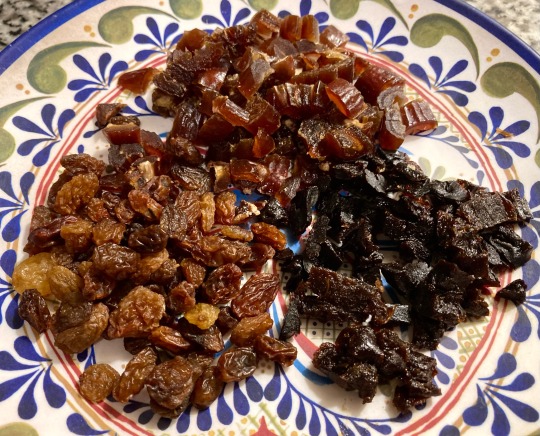
Instructions
1. Submerge wheat in water and scrub between your hands to clean and remove excess starch. Drain and cover by a couple inches with hot water. Cover and leave overnight.
2. Drain wheat and add to a large pot. Add water to cover and simmer for about 30 minutes until softened, stirring and adding more hot water as necessary.
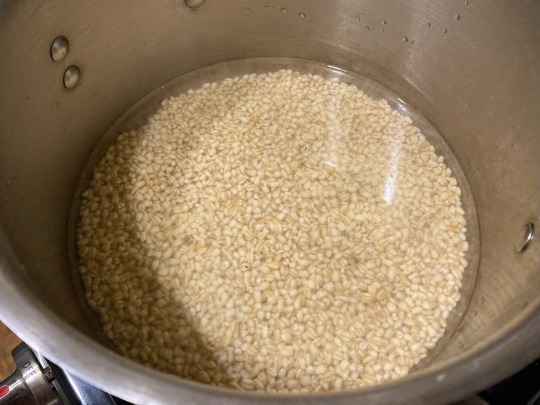
Wheat before cooking
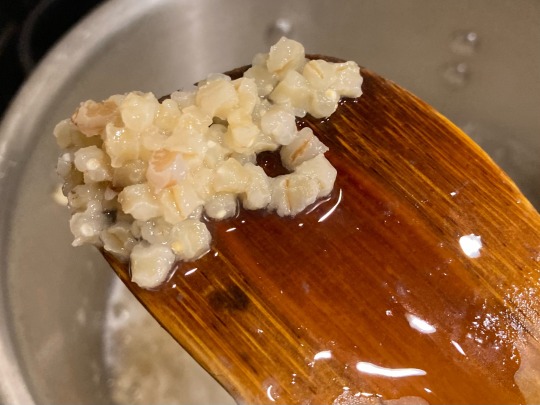
Wheat after cooking
3. Add dried fruit, sugar, salt, and spices and simmer for another 30 minutes, stirring occasionally, until wheat is very tender. Add water as necessary; the pudding should be relatively thin, but still able to coat the back of a spoon.
4. Remove from heat and stir in rosewater and honey. Ladle pudding into individual serving bowls and let cool in the refrigerator. Serve cold decorated with nuts and pomegranate seeds.
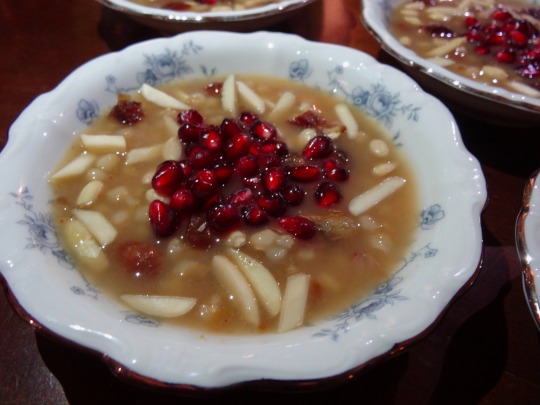
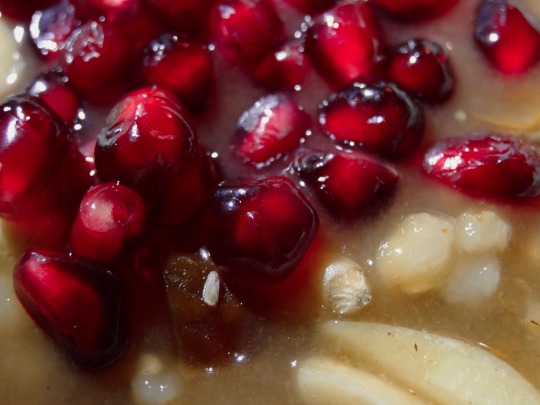
#the last link is a different / new fundraiser#Armenian#Palestinian#fusion#wheat berries#pearled wheats#pomegranate#prunes#dried apricot#dates#long post /
376 notes
·
View notes
Text

Mid-morning lunch at Ellis Island, 1926. The photographer wrote below the picture, "The attendant brings a milk lunch, a great improvement over former days, when prunes or prune sandwiches were the chief diet offered." Prune sandwiches?
Photo: Lewis W. Hine via NYPL
#vintage New York#1920s#Lewis Wickes Hine#Lewis W. Hine#Ellis Island#Ellis Island food#milk lunch#prunes#1920s New York#immigration#immigrants
44 notes
·
View notes
Text

「好きな果物は?」と訊かれたら、以前は「ネクタリン」と答えてたけど、最近は種無しで皮ごとバクバク食べられるブドウも良いですね〜ほぼ一年中食べられるし😋🍇 なーんて浮気してた私ですが、やはり9月は一番美味しい時期のバラ科の果物を食べた〜い❣️ということで、ちょっと大人買い?しちゃいました😆 てっぺんのはちょっと珍しい山形産のグリーンのプラム “ケルシー” です。
52 notes
·
View notes
Text

Vegan Miso Mushroom, Squash and Chestnut Wellington
#vegan#dinner#christmas#wellington#chestnuts#mushrooms#squash#butternut squash#miso#walnuts#parsley#thyme#garlic#prunes#chives#soy sauce#breadcrumbs#puff pastry#poppy seeds#olive oil#sea salt
26 notes
·
View notes
Text
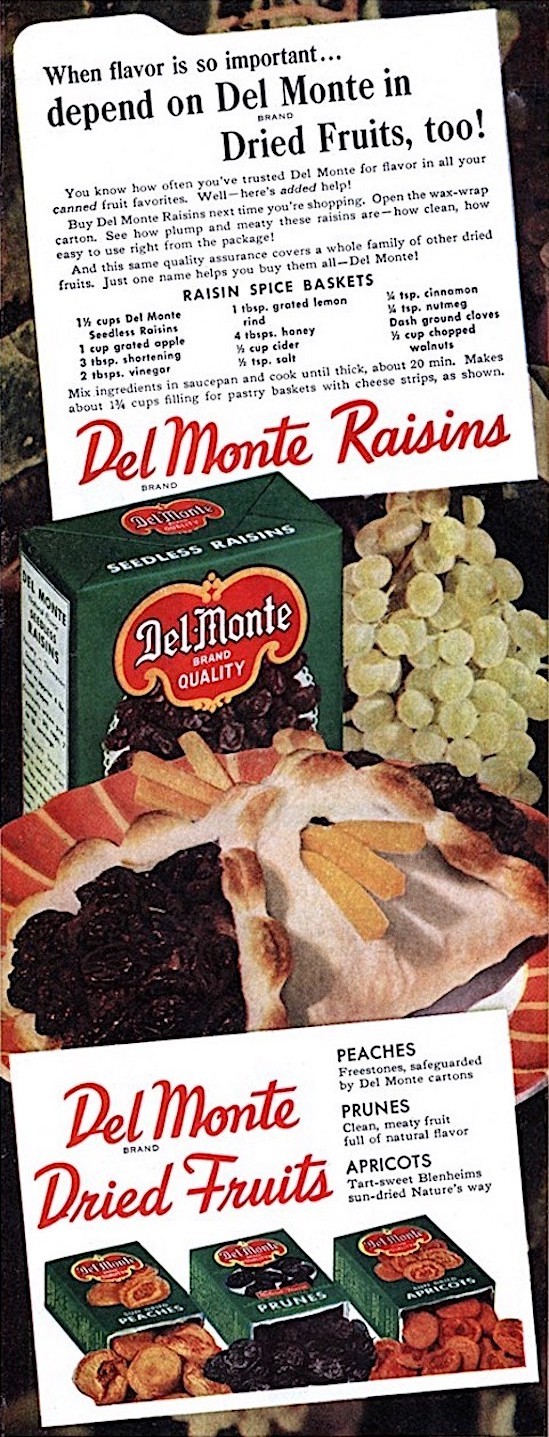
Del Monte Foods, 1949
#dried fruits#ad#1949#mid-century#advertisement#raisins#prunes#apricots#peaches#freestones#Blenheims#1940s#midcentury#recipe#advertising#dehydrated#sweet#retro#mid century
119 notes
·
View notes
Text
373 notes
·
View notes
Text

Prunes, prunes The magical fruit The more you eat The more you poop The more you poop The better you feel So it's prunes, prunes For every meal
Family Circle - January 1958
#1958#prunes#fruit#vintage ads#vintage ad#advertising#advertisement#1950s#1950s ad#1950's#1950's ad#funny#humor#humour
13 notes
·
View notes
Text
Ok I don't wanna sound like an old lady but. I'm eating prunes right now and they're FUCKING DELICIOUS. Like absolutely DELECTABLE. Like I'm talking SCRUMPTIOUS flavors dancing on my tongue. This is crazy. Fucking PRUNES??? The damn old people and constipation fruit???? Wild.
#prunes#who knew prunes were so good???????#maybe I'm just tired but this is god damn TOOTHSOME I'M IN SHOCK
54 notes
·
View notes
Text


Édouard Manet, Prunes, 1880
Édouard Manet, Pêches, 1882
#edouard manet#french art#french artist#french painter#french painting#still life#impressionist#french impressionist#impressionism#impressionist art#fruit#peaches#prunes#aesthetic#beauty#art on tumblr#art history#aesthetictumblr#tumblraesthetic#tumblrpic#tumblrpictures#tumblr art#modern art
27 notes
·
View notes
Text

Pasuts Tolma / Armenian New Year’s Stuffed Cabbage Rolls (Vegan)
#vegan#appetizer#lunch#armenian cuisine#middle eastern cuisine#dolma#cabbage rolls#cabbage#lentils#chickpeas#beans#bulgur#onion#parsley#dill#rice#basil#savory#tomato sauce#biber salçası#cayenne#prunes#olive oil#black pepper#sea salt
18 notes
·
View notes
Text
プルーン

プルーンは、プラムに似た小さな果物で、通常は乾燥させて食べられます。甘い風味と濃厚な色で知られ、世界中で人気の食材となっています。プルーンは、特にビタミンA、ビタミンC、カリウム、鉄分が豊富で、栄養価の高い食品です。それらはまた、食物繊維が豊富で、腸の健康を促進し、消化を助けることで知られています。プルーンは、生で食べたり、ヨーグルトやシリアルに混ぜたり、焼き菓子やスムージーに入れたりすることもで��ます。それらはまた、砂糖の自然な代替品として、料理やデザートに甘みを加えるために使用されることもあります。プルーンは、その抗酸化物質とビタミンの含有量から、健康的な食生活に関連付けられることが多いです。それらは、骨の健康、心臓の健康、免疫機能の向上など、さまざまな健康上の利点と関連付けられています。さらに、プルーンは、その高い食物繊維含量のため、腸の健康を改善し、便秘を予防するのに役立つと考えられています。
手抜きイラスト集
#プルーン#Prunes#fesso#ciruela pasa#prune#élaguer#手抜きイラスト#Japonais#bearbench#art#artwork#illustration#painting
2 notes
·
View notes
Text
Fruity Christmas Pudding

I've baked this rather special Chocolate and Apricot Figgy Pudding for the Holidays for a few years now, and it's always been a resounding success, both a decadent and moist and light dessert to indulge in until midnight strikes! I wanted to try something a bit different this year, and made this very Fruity Christmas Pudding. Laden with all sorts of dried fruit, mellowed and softened in Cognac, it is just as beautiful as the chocolate one! Happy Christmas, dears!!!
Ingredients (serve 6 to 8):
half a dozen large Medjool dates
half a dozen prunes
1/2 cup dried apricot
1/3 cup sultanas
1/3 cup dried cranberries
2 satsumas
1/3 cup good quality Brandy or Cognac (like Hennessy)
6 tablespoons unsalted butter, softened + more for greasing
½ cup demerara sugar
1 thumb-sized piece fresh ginger, peeled
3 large eggs
2/3 cup plain flour
½ teaspoon baking powder
1 ½ teaspoon Mixed Spice
1 cup Brioche Crumbs
1/4 cup almond meal
1/3 cup flaked almonds
1/4 cup very good Fig Jam (I used Fig and Almond Jam we brought back from our trip to Menton)
1 clean two pence or one pence coin
1/3 cup good quality Brandy or Cognac (like Hennessy)
The day before, pit and dice Medjool dates and plums. Dice dried apricots.
In a medium bowl, combine dice dates, plums and apricots with sultanas and dried cranberries. Grate in the zest of both satsumas, and thoroughly squeeze in their juice. Add the Cognac. Stir to mix well. Cover with cling film, and leave to soak, at room temperature, overnight.
The next day, cream butter and demerara sugar with a wooden spoon in a large bowl, until light, pale yellow and fluffy. Grate in fresh ginger, and stir until perfectly blended. Add the eggs, one at a time, beating well after each addition.
In a medium bowl, combine flour, baking powder and Mixed Spice. Gradually stir flour mixture into egg mixture; fold in gently until well-mixed.
Add Brioche Crumbs, almond meal, flaked almonds, Fig Jam and soaked fruits with their soaking liquid to the batter, and stir well. Drop the two pee in the pudding, make a wish, give a good stir, and give it to stir to anyone who’s at home, so they can make their wish too (from the oldest to the youngest!)
Generously butter a 2-quart pudding basin. Cut a small disc of baking paper and press into the base of the basin. Butter generously as well.
Spoon pudding batter into the prepared basin and press it down with the back of your wooden spoon. Cover the pudding with a layer of baking paper and foil, both pleated in the middle and tie securely with string. Trim off excess paper and foil with scissors.
Put a metal jam lid upside down at the bottom of a large pot to act as a trivet. Place a long double strip of of foil, letting it hang on both edges of the pot, to help you lift the pudding once it is cooked.
Lower the pudding in the pot, sit it on the band of foil, on the jam lid. Pour boiling water in the pot until it comes halfway up the pudding basin. Cover with a lid and bring back to a boil over medium-high heat. Once water is boiling, reduce heat to medium-low and simmer for 7 hours, regularly checking and adding boiling water so it is always halfway up the basin.
When cooked through, lift the pudding out of the pot. It should be a deep brown colour. Let cool a little, 15 to 20 minutes and turn pudding out onto serving plate. If you’re making it in advance, months ahead of Christmas, let cool completely and wrap tightly in cling film. Then place in a large metal tin (like a biscuit tin), and store in a cool, dark, draft-free place until Christmas.
On Christmas Day (or Eve, depending when you have it!) unwrap pudding and place in a buttered pudding basin, securing again with baking paper, foil and a string. Steam for about an hour.
Just before serving, quickly warm Brandy or Cognac, in a small saucepan, about 1 minute over low heat. Ignite carefully with a long match, and pour gently over the pudding, to flambé.
When flames die out, serve warm Fruity Christmas Pudding with Brandy Ice Cream.
#Recipe#Food#Fruity Christmas Pudding#Fruity Christmas Pudding recipe#Christmas Pudding#Christmas Pudding recipe#Pudding#Pudding recipe#Cake Pavlova and Pudding#Medjool Dates#Dates#Prunes#Dried Apricots#Sultanas#Dried Cranberries#Satsumas#Cognac#Butter#Demerara Sugar#Ginger#Eggs#Plain Flour#Baking Powder#Mixed Spice#Brioche Crumbs#Almond Meal#Flaked Almonds#Almonds#Fig Jam#Christmas
6 notes
·
View notes
Text
homunculus facts¡
homunculi have similar nutritional value to prunes but should not be eaten•
@strange-aeons released a video about us today• know your herstory•
i haven,t gone to kindergarten since the first day of school• i am a truant little boy•
the gods are dead and i am nibbling cutely at their corpses• nya ฅ^•ﻌ•^ฅ
hot tea is an abomination unto me this day• yea it shall be removed from my sight or thou shalt surely perish•
how many superman tv shows do they need to make anyway¿
#homunculus#homunculus facts#wizardposting#unreality#prunes#strange-aeons#hairless cats#skipping school#heresy#tea#lois and clark
25 notes
·
View notes
